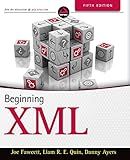Best Tools to Buy to Parse XML Attributes in December 2025
To parse attribute values from XML with Oracle, you can utilize the Oracle XML functions such as XMLType, extractValue, and XMLTable. XMLType can be used to convert the XML string into an XMLType object, extractValue allows you to retrieve the value of a specific XML element or attribute, and XMLTable can be used to extract values from multiple elements or attributes at once by defining an XQuery expression. By utilizing these functions, you can easily extract attribute values from XML data stored in an Oracle database.
What is the purpose of XMLType in relation to parsing attribute values in Oracle?
XMLType is a datatype in Oracle that is specifically designed to store and manipulate XML data. When parsing attributes values in XML documents in Oracle, XMLType is used to access and extract attribute values from the XML data. It provides methods and functions to extract attribute values, manipulate XML data, and perform various operations on the XML documents.
What is the performance impact of extracting attribute values from XML in Oracle?
Extracting attribute values from XML in Oracle can have a performance impact, particularly if the XML document is large or complex. The performance impact is influenced by factors such as the size of the XML document, the complexity of the data structure, the number of attribute values being extracted, and the efficiency of the XPath query used to extract the attribute values.
In general, parsing and processing XML documents can be resource-intensive, especially when extracting attribute values from nested or deeply nested elements. This can lead to increased CPU and memory usage, as well as longer processing times.
To mitigate the performance impact of extracting attribute values from XML in Oracle, consider the following tips:
- Use efficient XPath queries: Ensure that your XPath queries are optimized for performance, and try to avoid using complex or inefficient queries that can slow down processing.
- Limit the size of XML documents: If possible, work with smaller XML documents to reduce the amount of data that needs to be processed.
- Use XML indexes: Oracle provides XML indexes that can improve the performance of XML processing by enabling faster retrieval of attribute values. Consider using XML indexes to optimize the performance of attribute extraction.
- Cache attribute values: If you need to extract attribute values multiple times, consider caching the values to reduce the overhead of parsing and processing the XML document repeatedly.
By following these tips and optimizing your XML processing strategy, you can help minimize the performance impact of extracting attribute values from XML in Oracle.
What is the process for indexing attribute values for faster retrieval in Oracle?
The process for indexing attribute values for faster retrieval in Oracle involves the following steps:
- Determine which attribute values need to be indexed based on the queries that are frequently performed on the database.
- Create an index on the attribute(s) using the CREATE INDEX statement in Oracle. For example:
CREATE INDEX index_name ON table_name(attribute_name);
- Monitor the performance of the queries after creating the index to ensure that they are retrieving data faster.
- Consider using composite indexes for attributes that are frequently queried together. This can help improve query performance even further.
- Regularly monitor and maintain the indexes in the database to ensure optimal performance. This can include rebuilding or reorganizing indexes if necessary.
By following these steps, attribute values can be indexed in Oracle for faster retrieval, which can improve the overall performance of the database.



